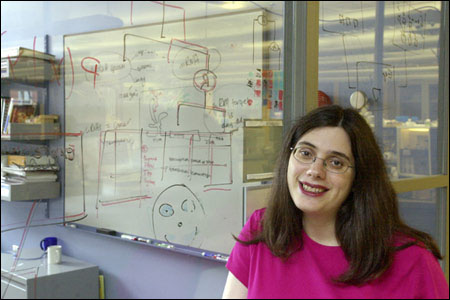Gene patterns found that ID cancers
May forecast who is most vulnerable

Patterns of gene turn-ons and turn-offs have been tied to the presence of 22 different tumor types in studies at Harvard University. Such information could more accurately predict who gets what cancer and whether it will spread, as well as lead to new types of treatments.
Many cancers have been associated with changes in the activity of single genes, those that promote or prevent tumor growth for example. This new analysis shows that some of these genes work with other genes and occur in other cancers. And it discloses that such patterns are also involved in the spread of tumors that survive surgery, radiation, and drugs.
“Most cancer researchers look only at single genes they know are associated with specific cancers, the cancers they specialize in,” notes Aviv Regev, a fellow at Harvard’s Bauer Center for Genomics Research. “But genes act together, not in isolation. Researchers often don’t see these patterns because they don’t look for them.”
Lots of turn-offs
Regev and her colleagues uncovered previously unknown gene patterns by studying data on tumor cell samples analyzed with so-called microarrays, silicon chips that check the activity of thousands of genes at one time. The researchers examined 1,975 microarrays published by different cancer researchers. The idea for doing this hit them when they started discussing how to make their own work less boring.
Two of Regev’s long-time collaborators, Eran Segal and Daphne Koller, work at Stanford University. One day, along with Nir Friedman from the Hebrew University in Jerusalem, they were discussing their microarray investigations of gene activity in yeast.
“It’s a beautiful, convenient system to study,” Regev comments. “Many of the biological functions in yeast have been conserved over hundreds of millions of years of evolution and still exist in higher organisms, from fruit flies to humans. We were sitting around chatting when we came up with the idea of applying our methods to microarray data from experiments on human tumors. Lots of data is available from researchers working on individual genes associated with human cancers, but no one was putting it all together. We decided to do this ourselves. We had no idea what we were getting into.”
None of them are cancer researchers, and humans are much more complicated than yeast, but they plunged ahead. The team combined and analyzed by computer 1,975 microarrays of 22 cancer types. “This is the first time such a thing was done,” Regev notes.
The team identified groups of genes that are turned on or off in each cancer type. They found that particular tumors are characterized by a relatively small number of gene groups, which they call modules. Some of the modules characterize only one type of cancer, but others are shared by many different malignancies.
In certain leukemias (acute lymphoblastic leukemias), they found in a module of 16 genes involved in tumor suppression, all are turned off, or turned down. These turn-offs allow tumor cells to grow without control.
“Cancer researchers have only been looking at one of these genes,” Regev notes. “But a whole system of genes is being stifled together. In diagnosing and treating such leukemias, then, all of these genes must be considered, not just one.”
Breasts and bones
Even more dramatic were findings that other modules are shared by a number of different cancers, suggesting that one mechanism can cause tumor growth in different malignancies. They discovered, for example, that a module of genes involved in bone growth is also active in breast, lung, liver, and, possibly, other tumors.
“Our results show that the same module active in breast tumors is active in normal bone growth,” Regev explains. “When we first saw this, we thought we had a problem with the method we used for the analysis. You ask yourself what the two have in common. One major thing is that breast tumors like to spread to bones. The same is true for lung, liver, and prostate tumors.”
It’s one of the saddest and most painful aspects of cancer: Patients have their primary tumors treated with surgery, radiation, or chemotherapy, only to later find that the malignancy has spread to their bones, where it is particularly difficult to treat.
“We think that cancer cells hijack the genes involved in bone-cell growth and then use them for their own benefit, that is, to promote their own growth,” Regev says. “The genes are active well before spreading starts, so there may be a chance of using this information to suppress, even stop, the spreading.”
A woman who undergoes surgery to excise a breast tumor, or a man to remove a prostate tumor, could have the tumors examined to determine whether the bone genes are present. If so, treatment could be initialed to try to stop spreading before it starts.
Regev emphasizes that such assumptions from computer analysis must be confirmed in tests with patients. “But,” she adds, “the computer evidence is so overwhelming, we feel there is a good chance that it will be validated by medical evidence.”
The researchers published details of their analyses in the October issue of Nature Genetics. They have also established a Web site that researchers and physicians can use to see what gene modules are involved in malignancies they study or treat in patients. Regev points out that “they may find modules that play roles they are not aware of and have a bearing on the diagnosis, prognosis, and treatment of patients.”




